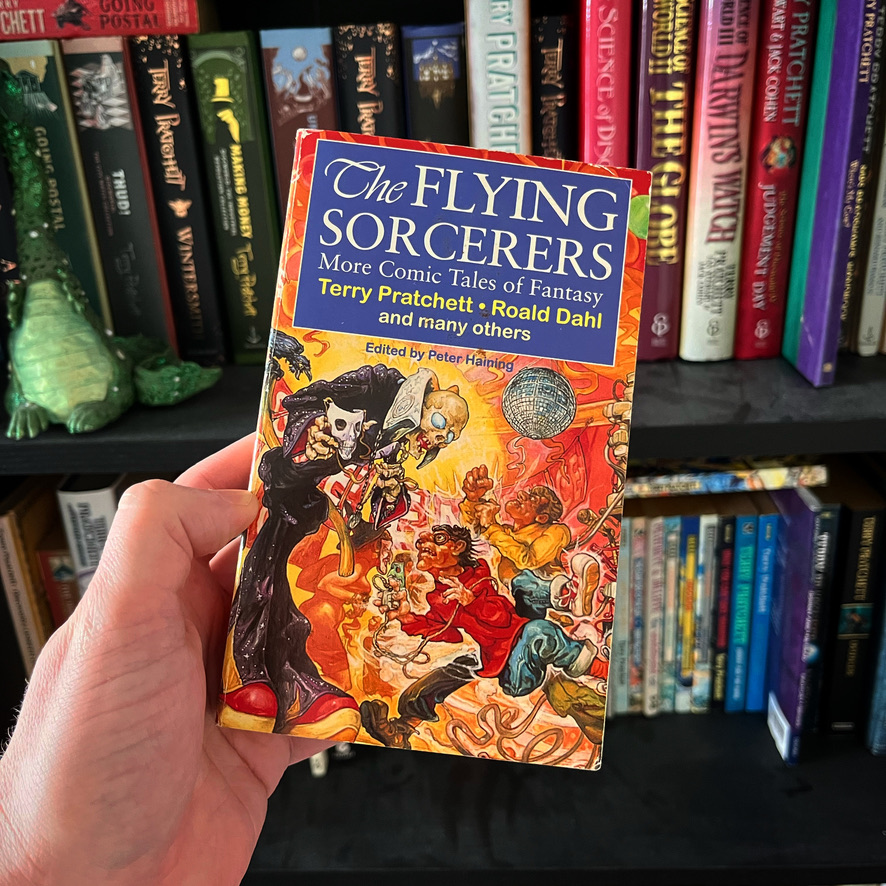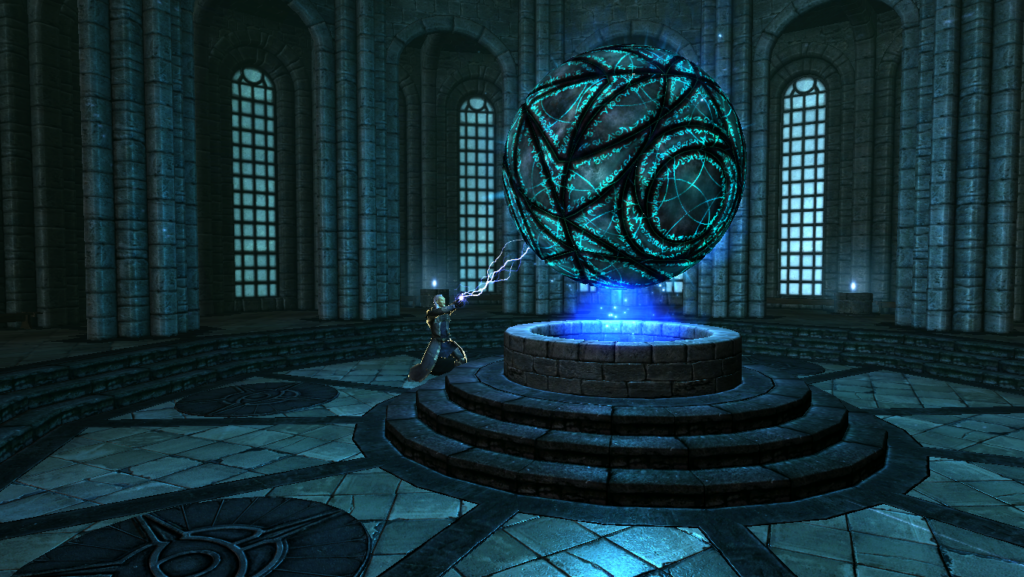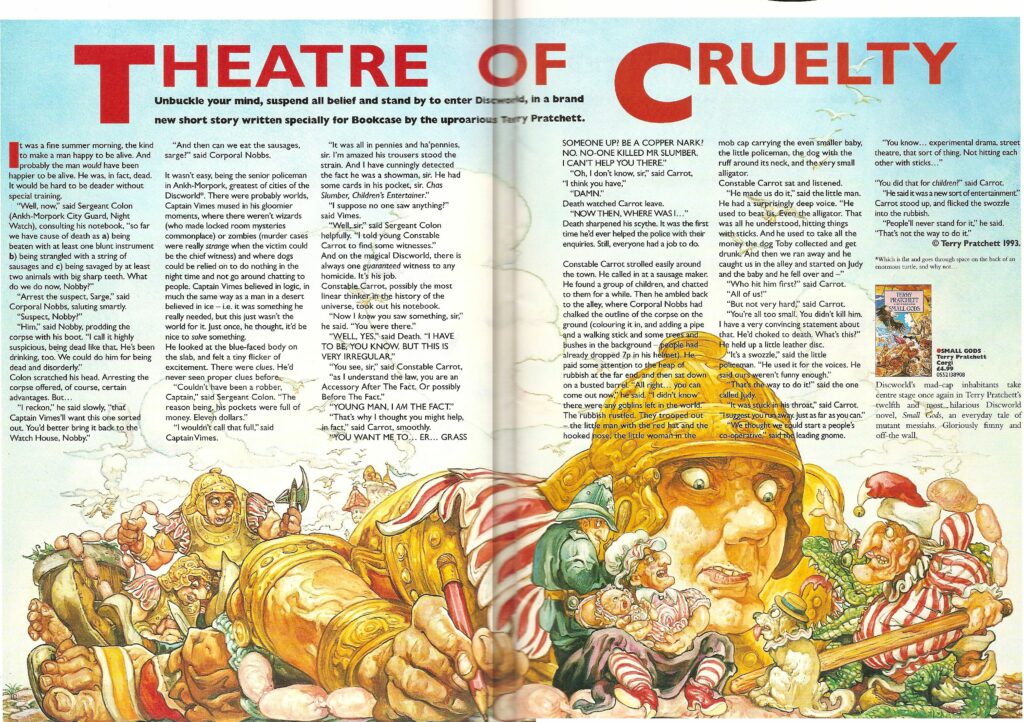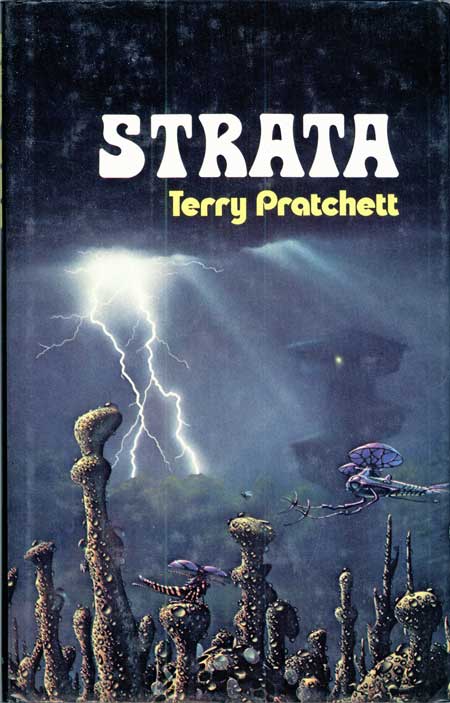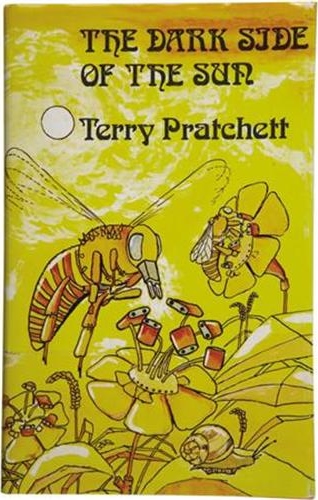#Pratchat74 Notes and Errata
These are the episode notes and errata for Pratchat episode 74, “Hogswitch”, an interview with the authors of Tiffany Aching’s Guide to Being a Witch, Rhianna Pratchett and Gabrielle Kent.
Iconographic Evidence
Notes and Errata
- The talk at the British Library mentioned by Rhianna is the book’s launch event at the British Library, organised by the Living Knowledge Network and held in conjunction with the “Fantasy: Realms of Imagination” exhibition. It was held on 27 October 2023, the day after the book’s original release date – the release was delayed by Typhoon Saola, which delayed shipping to the UK including the initial supplies of the book. You can watch the whole event on the Living Knowledge Network website.
- The talk at Waterstones Picadilly is not available as a video or audio recording; you had to be there, folks! For those not in the know, Waterstones is one of the major book chains in the UK, and the Picadilly store is one of their flagship shops in London. Its hosted many Pratchett events in the past, including a midnight opening for The Shepherd’s Crown, an event for Crystal of Storms (see below), and many signings.
- Travelling Man is a games, comics and fantasy books business with stores in Leeds, York, Newcastle and Manchester in the UK. They also run their own small press. You can find outmore about them at travellingman.com.
- Crystal of Storms is Rhianna’s 2020 Fighting Fantasy book: a branching narrative told in the second person in which the reader chooses their path through the story, and also must occasionally roll dice to try and overcome obstacles and defeat monsters. The series was created by Steve Jackson and Ian Livingstone of Games Workshop fame in 1982. Crystal of Storms was part of a revival of the Fighting Fantasy books by Scholastic Books that began in 2017, one of six new books published along side new editions of the classic ones.
- Gabrielle’s previous seven books are:
- The Alfie Bloom trilogy: Alfie Bloom and the Secrets of Hexbridge Castle (2015), Alfie Bloom and the Talisman Thief (2016) and Alfie Bloom and the Witch of Demon Rock (2017)
- The three Knights and Bikes books: Knights and Bikes (2018), Knights and Bikes: Rebel Bicycle Club (2019) and Knights and Bikes: Wheels of Legend (2020)
- The first Rani Reports book, Rani Reports on the Missing Millions (2023)
- The second Rani Reports book is due to be published on 5 September 2024, and currently available info lists the title as Rani Reports on the Copycat Crimes.
- “Frou-frou” is term derived from French (originally the sound of a rustling bag), which has become British slang meaning overly ornamental or excessively fancy. (A famous example is the character Le Comte de Frou Frou from Blackadder the Third.) Frou-frou flavoured coffees might therefore include a pumpkin spice or salted caramel latte. We’ve no objection to any of this, by the way; enjoy your coffee any way you like! (Ben’s partner often has a bit of cardamom mixed into her coffee, and uses a spiced drinking chocolate on top of the frothed milk for a cappuccino.)
- Yorkshire Biscuit Tea is indeed a frou-frou flavoured tea, manufactured by the Yorkshire Tea company and marketed as tasting like “tea and biscuits”. They also have a “Toast & Jam” flavour, and both were at least temporarily available in Australia in 2023.
- There are several official Discworld and Terry Pratchett websites:
- terrypratchett.com – the main official source for Terry Pratchett news.
- dunmanifestin.com – the site for Dunmanifestin, the company created by Terry and Lynne Pratchett to hold copyright for Pratchett’s work, and the official site for the Terry Pratchett estate. Dunmanifestin directly publishes deluxe editions of various Pratchett works, like the Ultimate Discworld Companion and the upcoming graphic novel adaptation of Good Omens.
- narrativia.com – the production company that controls licensing rights for all Pratchett’s works since 2012.
- discworld.com – an official Discworld shop, originally known as PJSM Prints, founded, owned and run by Sandra and Jo Kidby. They originally sold only Paul Kidby’s art prints, but have since expanded to many other Discworld items, notably special editions of the books. (Note that Paul Kidby also has his own website, paulkidby.com, and sells items based on his artwork there, too.)
- discworldemporium.com – the Discworld Emporium is the other official Discworld merchandise shop, set up by Bernard and Isobel Pearson after they closed their first business, Clarecraft.
- Geoffrey Swivel is, as mentioned, Tiffany’s apprentice in The Shepherd’s Crown. In the novel Geoffrey uses he/him pronouns, but also makes it clear he doesn’t think of himself as either traditional gender. This led Rhianna and Gabrielle to update Geoffrey’s pronouns to they/them for Tiffany Aching’s Guide to Being a Witch. We’ll leave any further discussion for our episode about The Shepherd’s Crown (and eventual return to Tiffany Aching’s Guide).
- Spill words are a concept introduced in I Shall Wear Midnight. Mrs Proust, the city witch in Ankh-Morpork who runs Boffo’s Emporium, explains it to Tiffany: “A spill word is a word that somebody almost says, but doesn’t. For a moment they hover in the conversation but aren’t spoken”. We discussed them in #Pratchat66, “Ol’ No Eyes is Back”.
- Annagramma is the conventionally attractive mean girl and presumptive leader of the coven of young witches introduced in A Hat Full of Sky. In Wintersmith she takes over the steading that belonged to Miss Treason; she is only mentioned in passing in I Shall Wear Midnight, and plays a very minor role in The Shepherd’s Crown.
- You is the white kitten Tiffany gives to Granny Weatherwax in Wintersmith, described her as the daughter of “Pinky, the Widow Cable’s cat”. During research for Tiffany Aching’s Guide, Gabrielle connected this to Tiffany’s next book, I Shall Wear Midnight, where she tells her father about having to deal with a widow up near Slice who’d been dead two months, locked up alone in her house with her cats. The cats couldn’t escape the house and had started to eat her, including one who had a litter of white kittens in her bed…
- Granny Whitlow is the witch who built the gingerbread house in the Forest of Skund, as depicted in The Light Fantastic. Rincewind and Twoflower are led there by the gnome Swires when they need food, and steal Whitlow’s broomstick, which has handlebars, to escape the wizards sent to capture them. According to Swires, Whitlow herself hasn’t been seen in a long time, rumoured to have been “done up good and proper by a couple of young tearways”. This is usually interpreted as a version of the story of Hansel and Gretel.
- Marchessa is a young Krullian wizard who appears in The Colour of Magic, in the final book, “Close to the Edge”. She describes herself as a wizard of the fifth level, and wields Ajandurah’s Wand of Utter Negativity when taking Rincewind and Twoflower captive so they can be sacrificed. She is well informed about Rincewind’s history.
- Mistress Pullunder and Old Mother Dismass are mentioned briefly as Tiffany’s previous mentors at the start of Wintersmith. Dismass also appears during the sabbat at the start of Witches Abroad with Granny, Nanny and Gammer Brevis, discussing the shortage of young witches in the wake of Desiderata Hollow’s death. Her oracular ability causes her attention to wander backwards and forwards from the present moment in a manner not dissimilar to Mrs Cake. We discussed Witches Abroad way back in #Pratchat12, “Brooms, Boats and Pumkinmobiles”.
- The Butterfly Ball and the Grasshopper’s Feast is a 1974 concept album (and 1975 rock opera) written primarily by Welsh musician Roger Glover, best known as a bassist and member of Deep Purple. The album, credited to “Roger Glover & Guests”, features Ronnie James Dio (of Black Sabbath fame) and Micky Lee Soule, who was in the band Rainbow with both Dio and Glover. The album is based on the 1972 children’s book which Gabrielle mentions: The Butterfly’s Ball, and the Grasshopper’s Feast by Alan Aldridge and William Plomer. The book is itself based on an 1802 poem written by English banker, lawyer, abolitionist and Member of Parliament William Roscoe (1753-1831). The song Ben mentions is called “Love is All”, sung by Dio, and written by Glover, Dio and Eddie Hardin; it’s the nineteenth track, the second-last of the album. It was a number one hit in a few countries in Europe on release. Ben is probably incorrect about the music video being part of a larger animated film project, but it was definitely a hit on television: in Australia the song also made it into the top 10 in 1980 when the video was played on the music programme Countdown, and remained a frequently shown clip on the ABC for many years. It was also played regularly in France and some stations in the US, and featured in a 2021 trailer for French jeweller Cartier.
- The Jedi Path: A Manual for Students of the Force is Star Wars book written by Daniel Wallace, and first published in 2010. Similarly to Tiffany Aching’s Guide to Being a Witch, it’s presented as an in-universe book – though in this case a specific copy of the third edition training guide for Jedi, which has been owned or used by several Jedi characters from the films who leave notes and other marks on the book. It survived the destruction of the Order, and was eventually being given to Luke Skywalker, it’s “owner” at the time it was published. The original edition was inside a “Vault”, but it has been re-published several times since with some additional material added and minor corrections. A similar volume also by Wallace, Book of Sith: Secrets from the Dark Side, was first published in 2012 and later bundled with The Jedi Path and then also with two similar books, The Bounty Hunter Code: From the Files of Boba Fett (2013) and Imperial Handbook: A Commander’s Guide (2014). The most recent editions of all four were published by Chronicle Books in 2016.
- Toggenburgs are a medium-sized purebred variety of goat originally from the Toggenburg region of the Canton of St. Gallen in Switzerland. They’re very popular and farmed all over the world, known for their high milk production, though the UK has it’s own local breed, the British Toggenburg, recognised in 1921. Compared to the Pure Toggenburg, British Toggenburgs are bigger, heavier, have shorter hair and longer faces, a greater variety of coat colours, and make even more milk. One source we found described Toggenburgs as having a “robust nature” which makes them “a hardy goat able to look after its best interests,” which seems clear inspiration for the way goats are described in the Discworld books.
- Indira Varma is a British actor best known to nerds for her screen roles in Game of Thrones, Obi-Wan Kenobi and Torchwood, though she’s done plenty of other film and television – and will appear in the upcoming 2024 season of Doctor Who as a Duchess. She has narrated all the Witches and Tiffany Aching books for the new Penguin Audiobooks series, which also feature Peter Serafinowicz as Death, Bill Nighy as the voice of the author reading the footnotes, and Steven Cree as the Nac Mac Feegle. The illustration of Miss Level inspired by her appears on page 31 of Tiffany Aching’s Guide, as well as in the collection of portraits used in the endpapers.
- Joan Hickson (1906-1998) played Agatha Christie’s sleuth Miss Marple in the BBC television films adapting all twelve Miss Marple novels made between 1984 and 1992. She is the most recognisable screen version of the character.
- Big thanks to listener armcie, who managed to uncover Nanny’s scribbled-out note on page 22 via some ebook jiggery pokery. According to them, the note reads:
Brings back a memory. Mr Ogg had a similar party piece, and after narry two sips of scumble, he’d get out his party piece and wave it around, we did all laugh, though we’d all seen it plenty before.
Nanny Ogg, Tiffany Aching’s Guide to Being a Witch
- Tiffany’s favourite word being susurration is another classic bit of Terry re-using something he’d already written – in this case, his own answer to the question which he wrote for The Word, a publication for London’s Festival of Literature in 2000, three years before the publication of The Wee Free Men. In his introduction to the piece, he says these sorts of questions are referred to as “My Fabourite Spoon” items.
- Fecund means “very fertile”, and – like so many other English words – comes from the Latin (fecundus, “fertile”) by way of French.
- Crepuscular is an adjective meaning “of or resembling twilight”, but is more often used in its zoological context, where it means “active and dawn and/or dusk”, describing animals which are not diurnal (active during the day) or nocturnal (active during the night), but which inhabit the edge in between. A fitting word for a writer of edge witches!
- The Overlord series are videogames published by Codemasters and originally developed by Triumph Studios. In the games the player is “the Overlord”, the new incarnation of evil who resembles Sauron from Lord of the Rings, who must vanquish the heroes who defeated the previous incarnation to regain enough strength to again conquer the land. Initially too weak to fight on their own, the Overlord instead commands a small army of goblin-like “Minions” who come in various colours with different special abilities. The games are a dark comedy, and the first game particularly parodies Lord of the Rings, with the heroes who are the player’s enemies parodying various members of the Fellowship, but later games include other fantasy elements as well, notably . The games in the series are:
- Overlord (2007) for the XBox 360, PlayStation 3 and PC.
- Overlord: Raising Hell (2008); an expansion for Overlord.
- Overlord II (2009); a sequel to the original games for the XBox 360, PlayStation 3 and PC.
- Overlord: Dark Legend (2009); an Overlord II spin-off for the Nintendo Wii developed by Climax Action.
- Overlord: Minions (2009); an Overlord II spin-off for the Nintendo DS, also developed by Climax Action.
- Overlord: Fellowship of Evil (2015); a for the XBox One, PlayStation 4 and PC (developed in-house at Codemasters)
- Gnarl is the older minion who advises the new Overlord, and also does most of the narration for the player, since the Overlord themselves is a non-speaking character. He is played by Marc Silk, a prolific English voice actor who you’ve probably heard in something. He’s been Bob the Builder and various Danger Mouse characters, and been in some other classic videogames including Black & White and the Two Point series of sim games.
- Knights and Bikes is a 2019 videogame designed by indie company Foam Sword, which was formed by developers who had previously worked at Media Molecule on games like LittleBigPlanet and Tearaway. It was originally a PlayStation 4 exclusive but was later released on the XBox One and Nintendo Switch. The game is set on the small (and fictional) British island of Penfurzy in the 1980s, and one or two players control Nessa and Demelz, two young girls who explore the island on their bikes and have fantastic adventures inspired by films like Goonies.
- Adventure games are traditionally ones in which the player must navigate a story by examining their environment, talking to other characters and collecting and using objects to solve puzzles. The original text adventure games used typed commands, but in the 1990s companies like Sierra On-Line and LucasArts transitioned the genre into graphic or point-and-click adventures. These used graphics, sound and more-and-more sophisticated mouse-based interfaces to place the emphasis on the puzzles and their narrative solution instead of how to tell the game what you wanted to do, though some – including the original Discworld adventure game – were still very difficult. Telltale Games was a games development company founded in 2004 by ex LucasArts employees who developed a serialised, episodic format for adventure games. They started out making new stories featuring characters from the old LucasArts games, then moved on to using licensed characters and worlds like Back to the Future, Game of Thrones, Batman, The Walking Dead and the comic book Fables, which produced one of their most critically acclaimed games, The Wolf Among Us. The company collapsed in 2018 after revelations of extreme “crunch” culture – punishing hours and conditions for staff under pressure to meet unrealistic deadlines, something common in the videogame industry but at an extreme at TellTale. The name is now owned by a different company, LCG Entertainment, who re-released the TellTale Batman games and is working to complete a sequel to The Wolf Among Us.
- The Quarter Quell is an event in The Hunger Games books by Suzanne Collins and their film adaptations. In the future dystopia of Panem, the government responds to an attempted rebellion by instigating the “Hunger Games” – an annual lottery where a boy and a girl are selected from each of the twelve Districts as “tributes” who will fight to the death in a specially designed arena. The Games are televised, and each twenty-five years since the original they do a special “Quarter Quell” in which the usual rules are bent in some way; during the second novel, President Snow uses the 75th Hunger Games to bend the rules and make the protagonist Katniss fight again, something that is usually forbidden.
Thanks for reading our notes! If we missed anything, or you have questions, please let us know.


